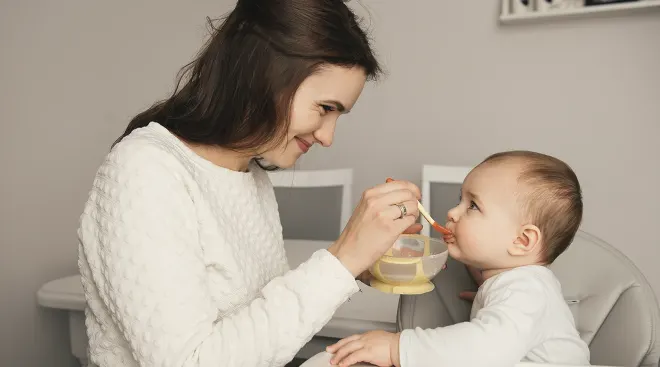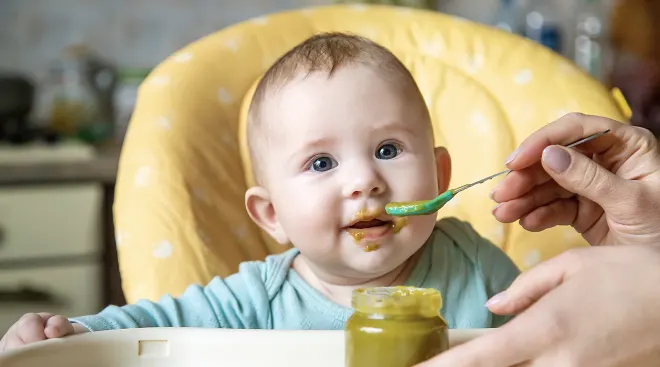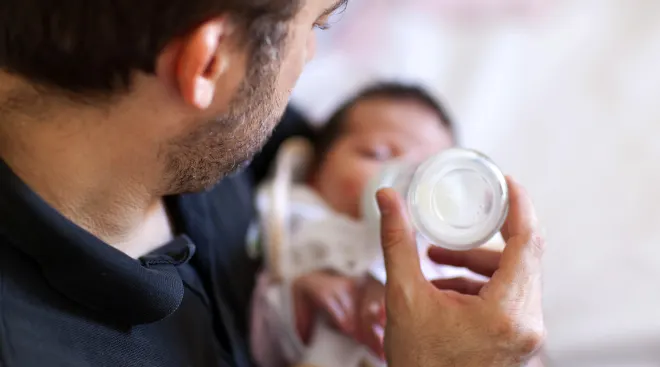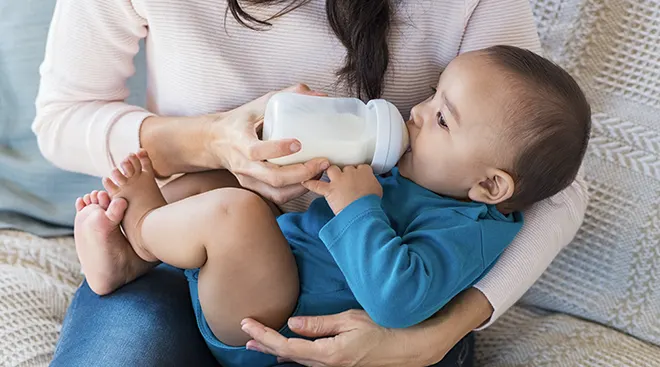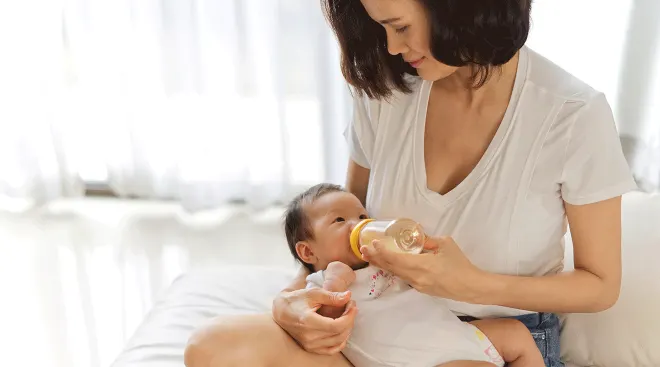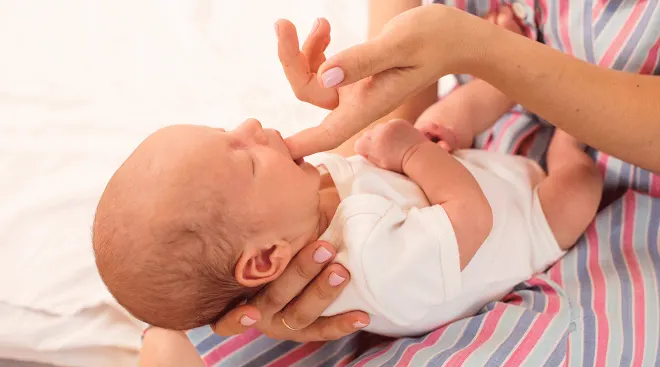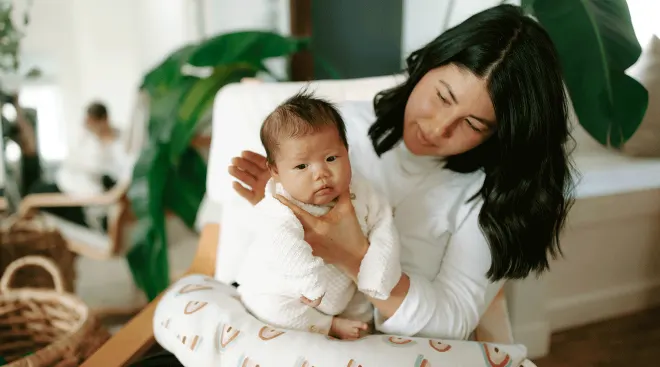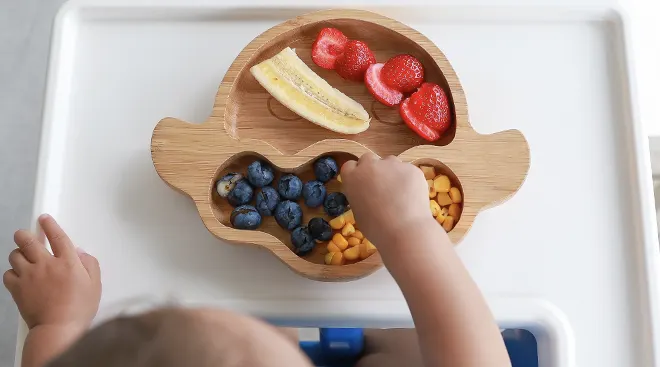When to Introduce a Pacifier for a Newborn
When you picture a baby, you might imagine them blissfully napping with a pacifier in their mouth—or maybe they’re rhythmically sucking on a binky while mastering a new skill. Either way, you may wonder: Why do babies like pacifiers?
Sucking is a primitive reflex—and one of the ways they self-soothe. An infant’s penchant for sucking is often satisfied at the breast or with a bottle—but that’s not a solution for all those moments between feedings. This is when a pacifier can come in handy. But when can you introduce a pacifier to baby? And are there any risks or side effects to paci use? Below, experts break down everything to know about newborns and pacifiers.
Wondering when to introduce a pacifier for baby? One of the most common concerns is if giving baby a pacifier will interfere with breastfeeding. “The way a baby sucks on a breast is different from the way they suck on an artificial nipple,” says Leigh Anne O’Connor, IBCLC, an international board certified lactation consultant and La Leche League leader in New York City. “Some babies can go back and forth between breast and artificial nipples, while others are more sensitive.” They may struggle with “nipple confusion,” the somewhat controversial idea that baby may become accustomed to—and come to prefer—the feeling and texture of a synthetic nipple, and might not want to feed at the breast. “Even in best-case scenarios, early breastfeeding is really hard for the first couple of weeks,” says Genevieve Brauning, MD, a family physician with Avance Care in Charlotte, North Carolina. “It’s probably a good idea to wait to introduce the pacifier [until] mom’s milk supply is well established and baby is easy and comfortable on the breast, usually between two and eight weeks.”
That said, some nursing moms have introduced pacifier use earlier without disrupting the breastfeeding experience. And, of course, if baby is bottle-fed from the start, you can give them the pacifier right away, since the nipple on the bottle is so similar.
Should a newborn use a pacifier?
A lot of first-time parents wonder: Are pacifiers bad for baby? Newborns are born with a basic sucking reflex, which is activated when something touches the roof of their mouth. “When the palate is stimulated [during sucking], it relaxes baby,” O’Connor says. A pacifier is essentially just a rubbery nipple, usually made from silicone or latex, designed to satisfy baby’s sucking impulse. In fact, pacifier use actually allows baby to suck more rapidly—two sucks per second, compared to one suck per second while feeding—so it accommodates their need to suck and helps them self-soothe that much faster. Point being: a pacifier can quickly calm your little one.
“Newborn babies cry a lot, and if you find something that’s soothing to them, that’s really nice,” says Brauning. “From a practical point of view, a pacifier is on the short list of things that can give everyone peace and quiet.” In other words, when you’re running on low sleep and can’t figure out why baby’s crying, a pacifier may be the first thing you turn to. Not surprisingly, between 75 and 85 percent of infants use pacifiers, according to American Family Physician.
In a nutshell, Tanya Altmann, MD, a pediatrician, spokesperson for the American Academy of Pediatrics (AAP) and founder of Calabasas Pediatrics, says you should give your newborn a pacifier between two and six weeks, once breastfeeding is established, as they may not take to it if you wait too long. That said, each baby—and their timeline for taking a paci—will be different.
What type of pacifier should I introduce?
Infant pacifiers have different nipple shapes: Some are flatter, which manufacturers claim may be better for orthodontic issues (more on that below), and some are rounder, shaped more like the nipple on a bottle. Either way, there’s little evidence that one shape is superior; it may be a matter of trial and error to see which pacifier baby loves most.
That said, the American Academy of Pediatrics (AAP) recommends choosing a pacifier with one-piece construction. A one-piece pacifier doesn’t have any attached parts that could come loose and present a choking hazard.
(Need help finding the perfect pacifier? Check out our favorites.)
Believe it or not, there are some major benefits to pacifier use. Aside from soothing baby and reducing crying, here are a few more reasons why pacifiers are so popular with parents (and babies!).
Reduces the risk of sudden infant death syndrome (SIDS)
The AAP encourages pacifier for naps and bedtime to help reduce the risk of SIDS, Altmann says. “This is likely because sucking stimulates the breathing center in the brain, or sucking on a pacifier helps keep the airway open.” (However, never attach a pacifier to baby’s neck or crib with a strap, as this can be a strangulation hazard.)
Encourages breastfeeding in moms with PPD
A study in the Journal of Human Lactation showed that mothers at high risk for postpartum depression did better with breastfeeding if their baby used a pacifier. As baby learns to self-soothe, Mom gets a little extra time between feedings, making breastfeeding potentially less stressful. In this case, pacifier use offers emotional support for both Mom and baby.
Distracts from stressful stimuli
Pacifier use during unpleasant situations—like a vaccination, a painful procedure or a run-of-the mill bump—can help make baby less upset. “It’s been documented that offering a pacifier can provide pain relief,” Brauning says. “It reduces how baby senses pain and makes them more comfortable.”
Helps preemies thrive
Researchers have found that pacifier use among preterm babies results in shorter hospital stays and better bottle-feeding. The study showed possible improvement in digestion when babies with less than 32 weeks gestation sucked on a pacifier during gavage feedings (i.e. when nutrients are delivered to the stomach via a small tube up the nose).
Eases air travel
Planning a trip? Pack a few pacifiers in your carry-on. “The sucking motion of the jaw provides a shift in the middle ear, where baby can feel pressure when the plane is going up or descending,” says Wendy Sue Swanson, MD, pediatrician and adjunct professor of medicine at Stanford. (Breastfeeding or bottle-feeding will work just as well.)
While pacifiers offer plenty of benefits for babies, these are most common concerns about pacifier use that are important to be aware of before offering up that binky:
Dental problems
Long-term pacifier use can affect the shape of the teeth and mouth, especially if baby continues to use it well into the toddler years. The jaw and the gum tissue are very malleable, and constantly keeping a pacifier behind the front teeth after age 2—but especially after 4—can create dental problems like an overbite or crossbite, Swanson says. And while there’s little evidence that baby pacifiers lead to speech delays, it can be hard—to say the least—to figure out what a toddler is saying when they’re trying to talk with a piece of plastic dangling from their mouth.
Risk factor for ear infections
A study of almost 500 children in Finland has connected pacifier use to ear infections. Children in the study who didn’t use pacifiers continuously had about one-third fewer ear infections than those who did use them. The theory is that when baby sucks or swallows, there’s a change in pressure behind the ear, which may shift fluids into the middle ear and cause an infection, Brauning says. There’s also the risk of pacifier germs. To decrease the incidence of baby’s ear infections, the AAP recommends reducing or eliminating baby’s pacifier after 6 months old. One compromise: Limit pacifier use to naps and bedtime, rather than allowing baby to suck on it all day.
Potential weight gain
A 2017 Childhood Obesity study showed that infants who used a pacifier past 4 months were about 10 percent more likely to be overweight by age one, and 20 percent more likely to be overweight by age 2, compared to infants who didn’t use one. Why the potential weight gain? Unfortunately, researchers haven’t been able to settle on a specific explanation behind the correlation. However, they also found that pacifier use was associated with shorter breastfeeding sessions and less responsive parental feeding styles.
Pacifier dependence
Babies are instinctive creatures: If something feels good, they’re going to keep doing it. Unfortunately, that means pacifier use can become addictive to babies and toddlers—picture baby howling at 2 a.m. when the paci falls out of their mouth, or a meltdown when it drops into a mud puddle and you forgot to pack an extra. Plus, social media is always filled with desperate parents trying to find pacifier weaning solutions that don’t end in hysterics. For an easier transition, experts recommend starting to wean by one year, or even earlier—by 6 months, baby should be sleeping through the night, Swanson says, and since they’re too young to argue with you, you can easily go cold turkey.
A crying baby may be ready to suck on a pacifier right away, or they may grimace, squirm and spit it out. For successful pacifier use, you’ll want to follow baby’s cues, and keep the following tips in mind:
Learn to spot the sucking reflex
Figuring out whether they’re hungry or just want to suck on something isn’t so much a philosophical question for infants as much as it is an observation on parents’ part. Fortunately, figuring out what baby wants can be fairly intuitive. Since nursing is often the first line of action to appease both hunger and soothing cues, infants may feed hourly. By the time they’re 6 to 8 weeks old, feedings start to follow a reliable routine, so you can tell if baby’s hungry or just fussy. “Satiated babies stop sucking hard enough to get milk out of breast or bottle—they might even push it away,” says Brauning. “But they might still take a pacifier if they need comfort.” (However, if baby’s still rooting and turning their head, then they’re most likely hungry, adds Altmann.)
Try dipping it in breast milk or formula
Altmann recommends dipping the pacifier in breast milk or formula. Or, you may try running it under warm (not hot!) water before offering it to baby. (But never dip the pacifier in sugar or honey—more on that below.)
Know when to stop trying
Some babies don’t have a high suck demand and simply have no interest in pacifier use. “If baby isn’t taking the pacifier, it’s not necessarily the right soothing technique for them,” Brauning says. In other words, don’t force a paci if baby doesn’t want it. They’ll find an alternative soothing mechanism that works for them, like sucking their thumb or even puckered air-sucking.
While pacifiers are pretty safe to use and offer to your little one, there are some safety tips to keep in mind. The experts note them below:
Keep it clean
One thing that’s a guarantee in babyhood? Dropping the pacifier. After the umpteenth time baby drops it, you’ll probably be tempted to just hand it right back to them—but is that safe? Sorry, but if baby drops their pacifier on the floor or if it gets dirty, Altmann says it’s best to disinfect and rinse it before you give it back to them.
Be mindful of its size
Pacifiers come in a variety of sizes recommended for different ages and can pose a choking hazard if used incorrectly. “Pacifiers for younger babies are often smaller and more flexible, which can pose a choking risk for older babies,” Altmann says, anecdotally adding, “I’ve seen a 9-month-old fold and put the entire pacifier made for a 3-month-old in their mouth, and then it popped back open and they started choking.” As babies get older, their pacifiers will become firmer and larger.
Choose a pacifier that’s designed as one solid piece
Swanson recommends choosing a pacifier that’s made of one solid piece, so it can’t break apart in baby’s mouth. Plus, pick pacifiers that have ventilation holes—they let air circulate, reducing the chance of a messy red rash developing around baby’s mouth.
Keep an eye out for product recalls
From time to time, certain baby products do get recalled, so it’s a good idea to keep an eye out for pacifier recalls on the Consumer Product Safety Commission’s website.
Don’t coat it in something sweet or sticky
Dipping the pacifier in sugar can be dangerous for baby, as it can cause cavities later on. Honey is also a no-no, since it’s dangerous for babies under one year, as it can cause infant botulism.
Sometimes babies decide they’re done with pacifiers and just stop pacifier use on their own. If that happens, consider yourself one very lucky parent! Otherwise, there will come a time when you’ll have to do the dirty job of taking it away or starting to wean around 6 months to a year. Ideally, for dental development, you want to try to say bye-bye to the binky permanently by your child’s second birthday. “Baby will cry for a little while, but after a couple of days, they’ll adjust and figure out another way to self-soothe,” Swanson says.
Frequently Asked Questions
Do pacifiers cause gas?
Babies are gassy by nature, so it’s normal to wonder if their pacifier is a contributing factor. However, according to Altmann, it most likely isn’t.
Are there any benefits to not using pacifiers?
“If you don’t offer a pacifier, some babies will find their hand or another method of self soothing,” Altmann says. “Pacifier use may also be associated with an increased number of ear infections.”
How many pacifiers do I need?
This will depend on baby’s preferences and how often they use their pacifier. Altmann recommends having up to six, depending on your budget. “Most families like to have three to six pacifiers—ideally one where your baby sleeps, one in the diaper bag and an extra.”
How long should baby use pacifier in a day
According to Altmann, some babies have a stronger urge to suck, so how long baby uses a pacifier each day may depend—and it may look different each day. But to keep baby from becoming dependent on it, try to limit usage to naps and bedtime. “Use it just to help them fall asleep and then don’t reinsert it if it falls out. Or, use it only when they’re fussy,” Altmann suggests.
What if baby’s pacifier keeps popping out?
Sometimes baby will push their paci out of their mouth, or sometimes it will fall out on its own. In these instances, Altmann recommends trying a different type of pacifier that may stay in their mouth longer, such as one with a more rounded shape. And if it falls out while baby’s asleep—as long as baby’s not fussy—there’s no need to reinsert it.
Please note: The Bump and the materials and information it contains are not intended to, and do not constitute, medical or other health advice or diagnosis and should not be used as such. You should always consult with a qualified physician or health professional about your specific circumstances.
Plus, more from The Bump:
Tanya Altmann, MD, is a pediatrician, spokesperson for the American Academy of Pediatrics and founder of Calabasas Pediatrics. She’s also a bestselling author of books like Baby and Toddler Basics. She completed her residency at UCLA and received her medical degree from Sackler School of Medicine in New York City. She currently also serves as an assistant clinical professor at UCLA Mattel Children’s Hospital.
Genevieve Brauning, MD, is a family physician with over 18 years of experience with Avance Care in Charlotte, North Carolina. She earned her medical degree from the University of Virginia School of Medicine and completed her residency at Carolinas Medical Center in Charlotte.
Leigh Anne O’Connor, IBCLC, LCCE, is a board-certified lactation consultant based in New York City with over 20 years of experience. She has served on the Board of the New York Lactation Consultant Association and has been an accredited La Leche League Leader for over two decades. O’Connor is also a Lamaze Certified Childbirth Educator.
Wendy Sue Swanson, MD, is pediatrician and adjunct professor of medicine at Stanford, as well as director of digital health at Stanford’s Sean Parker Center For Asthma and Allergy Research. She earned her medical degree and a master’s degree in bioethics from the University of Pennsylvania Perelman School Of Medicine. She completed her residency at Seattle Children’s Hospital.
American Academy of Pediatrics, Policy on Pacifiers, 2022
American Family Physician, Risks and Benefits of Pacifiers, April 2009
Journal of Human Lactation, Pacifiers and Exclusive Breastfeeding: Does Risk for Postpartum Depression Modify the Association?, August 2017
Cochrane Database of Systematic Reviews, Non‐nutritive sucking for promoting physiologic stability and nutrition in preterm infants, October 2005
Pediatrics, Pacifier as a Risk Factor for Acute Otitis Media: A Randomized, Controlled Trial of Parental Counseling, September 2000
Childhood Obesity, Pacifier Use and Early Life Weight Outcomes in the Intervention Nurses Start Infants Growing on Healthy Trajectories Study, October 2017
Learn how we ensure the accuracy of our content through our editorial and medical review process.
Navigate forward to interact with the calendar and select a date. Press the question mark key to get the keyboard shortcuts for changing dates.



































